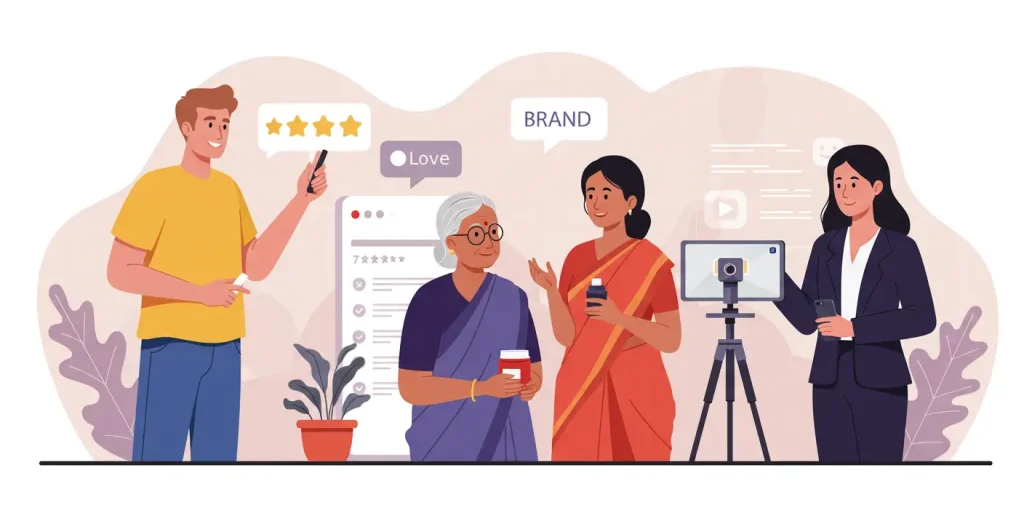Why Brand Advocacy is the Key to Sustainable Growth
Your marketing budget is being wasted. Every. Single. Day.
While you're pumping cash into Facebook ads and TikTok campaigns, your competitors are leveraging something infinitely more powerful and virtually free: their existing customers.
I'll be blunt—93% of consumers trust recommendations from people they know over ANY form of advertising. Yet most businesses spend less than 10% of their marketing resources nurturing those relationships.
This isn't just a missed opportunity. It's business suicide.
What if I told you that increasing customer retention by just 5% can boost profits by 25-95%? Or that your loyal advocates spend 67% more than new customers?
Brand advocacy isn't just some fluffy marketing term—it's the difference between struggling for every new sale and creating a self-perpetuating growth machine that prints money while you sleep.
In this article, I will show you exactly how the fastest-growing companies transform satisfied customers into an unpaid sales army that outperforms your most expensive marketing campaigns.
The math is simple. The strategy is proven. And your competition is praying you don't figure it out.
But first, Let me share some statistics that show how things are changing this year…
- Facebook's organic reach flatlined at 1.37% – lower than the chance of being struck by lightning. Yet 78% of consumers now prefer private communities over public feeds, creating a £22.6B “dark social” economy in brand advocacy channels like Discord and WhatsApp.
- TikTok engagement dropped 35% YoY1 as nano-influencers (sub-10K followers) now drive 6.8x more conversions than mega-influencers. Authenticity outperforms production value.
- The advocacy software market grew 12.1% to £352M in 2025 – not because it's trendy. AI-driven tools now predict advocacy potential with 89% accuracy, turning casual buyers into megaphones.
What These Numbers Mean
The “attention economy” is dead. We're in the trust recession – where consumers treat public social metrics like a rigged casino. Brands are still fixated on vanity metrics and polishing the Titanic's brass.
The real shift? Advocacy arbitrage. Smart players like BrandAlley achieved 70% repeat purchase rates by weaponising customer joy into a growth engine. Their secret? Treating positive reviews as collateral for loyalty loans – reward advocates will bankroll your growth.
- 93% of consumers trust recommendations from friends over other advertising methods, making customer relationships invaluable.
- Brand advocacy can boost profits by 25-95% with just a 5% increase in customer retention.
- Effective systems to nurture advocates can turn customers into powerful unpaid sales forces.
- Engaging and nurturing loyal customers through exceptional experiences builds authenticity and trust for the brand.
- Companies like Tesla and Starbucks successfully leverage community engagement and loyalty programs to drive brand advocacy.
Importance of Brand Advocacy

Brand advocacy isn't just a buzzword; it's a strategic approach offering many benefits for businesses. Let's talk about why fostering brand advocates is essential for your organisation.
Enhancing Trust and Credibility
Customers who advocate for your brand become powerful voices on your behalf. Why? Because people trust peer recommendations over traditional advertising.
- Real Experiences Matter: Imagine you're hunting for a new café. You're likelier to pick one a friend raves about than a paid ad, right? Studies show that 92% of consumers trust recommendations from friends and family over any other form of advertising.
- Building Authenticity: When your customers share their positive experiences, it constructs a genuine image of your brand. The more authentic you appear, the more trustworthy you become in the eyes of potential customers.
Trust is a currency. You earn it by encouraging your customers to share their experiences and anecdotes about your brand. The more they talk, the more credibility you gain.
Cost-effectiveness Compared to Traditional Marketing
Let's hit the numbers. Traditional marketing campaigns can be expensive. From print ads to television spots, costs can skyrocket. In contrast, brand advocacy is cost-effective and can deliver excellent returns on investment.
- Lower Marketing Costs: You don't have to shell out for ads when your loyal customers promote for you. Word-of-mouth marketing is free! Your overarching investment becomes customer engagement instead of expensive ad slots.
- Higher ROI: Advocate-driven marketing typically sees a 30% higher conversion rate than regular marketing strategies. When someone recommends your brand, potential buyers are more inclined to trust it and make a purchase.
Consider the tale of a small local bakery. Instead of spending thousands on spreading the word about their pastries, they focused on customer loyalty and word of mouth. The traffic they gained from advocates allowed them to expand without breaking the bank.
Driving Organic Awareness and Media Attention
When you have brand advocates, your reach expands without even lifting a finger. Their enthusiasm can spark organic conversations that put your brand in the spotlight.
- Virality Potential: Each time someone shares their love for your product on social media, it may reach their followers. This growing chain reaction can lead to your brand trending.
- Media Features: Journalists and bloggers love brands with enthusiastic followers. When advocates share positive experiences, it raises the eyebrows of media outlets looking for authentic stories. Your brand could become featured in various publications, driving even more awareness.
For instance, think about a cycle company encouraging its community to share rides on social media. Those happy customers sharing hashtags and experiences can catch the attention of outdoor magazines, spinning your brand's visibility to new heights.
Staying Ahead of the Competition
In a competitive marketplace, brand advocacy can be your secret weapon to stay a cut above the rest.
- Easier Differentiation: In industries where products can be similar, advocacy helps differentiate your brand as your loyal customers share why they choose you over competitors.
- Loyalty Over Price: When people believe in your brand, they often overlook price differences. It's not just about the product anymore; it's about the relationship and values behind it.
Take Nike. Their advocates aren't just customers; they're a community. When a company fosters this robust support system, it keeps its customers. It constantly attracts new ones, leaving competitors in a dust cloud.
In essence, brand advocacy builds a foundation of trust while being cost-effective. It drives organic visibility and positions you ahead of rivals. In branding, advocates are akin to gold—valuable, rare, and transformative. Invest in them, and watch your brand soar.
Key Components of Brand Advocacy
Now that we've established why brand advocacy is vital for your organisation, let's dive into the key components that make this advocacy thrive. It's not just about loud voices shouting your praises; it's about strategic relationships that build a strong brand presence.

Loyal Customers
First up, loyal customers are the backbone of any brand advocacy effort. These people repeatedly choose your brand over competitors and happily share their experiences.
- Emotional Connection: Loyalty isn't just a transaction; it's a relationship. When customers feel a connection to your brand, they become emotionally invested. Think of the way Apple enthusiasts talk about their devices; they don't just see them as gadgets but as part of their identity.
- Word of Mouth Amplification: Loyal customers are more likely to recommend you. 77% of consumers are more likely to buy a product after hearing about it from a friend. So don't take your loyal customers for granted; nurture that connection!
For example, a local craft brewery often hosts community events and engages with its patrons. They build personal relationships, and as a result, these customers turn into loyal advocates, spreading the word about their unique brews.
Engaged Employees
Next, engaged employees are essential spokespeople for your brand. They play a crucial role in developing the narrative around your company and influencing how others perceive it.
- Passion Translates: When employees believe in your brand's mission, that passion shines through. Companies with engaged employees outperform those without by up to 202%. When your team is excited to represent your brand, it creates a ripple effect.
- Internal Advocacy: Employees can act as advocates both internally and externally. Imagine your staff sharing positive experiences on social media or talking about your product at casual gatherings. They translate the internal culture to the outside world, acting as natural ambassadors.
Let's think of Zappos, the online shoe retailer. Their employees are encouraged to go above and beyond to help customers. This cultural engagement results in fantastic service, which advocates raving about and effortlessly spreading the word about Zappos.
Influential Partners and Influencers
Finally, influential partners and influencers can significantly boost your brand advocacy. They usually have vast networks and credibility that can elevate your brand's visibility.
- Strategic Collaborations: Collaborating with partners who share your values can increase your reach without extensive effort. Think about co-hosting events or producing joint content that showcases both brands in a mutually beneficial light.
- Leveraging Influence: Influencers are not just social media celebrities but trusted voices in niche markets. Appropriate partnerships can lead to your brand being presented as a reliable choice to their followers. For instance, fitness influencers promoting health supplements create awareness and trust.
Remember the skincare brand The Ordinary? They've built a robust community through collaborations with beauty influencers. These advocates introduce their products to thousands of potential customers who already trust the recommendations of these influencers.
In summary, the key components of brand advocacy—loyal customers, engaged employees, and influential partners—are all interconnected. Cultivating these relationships builds a robust support system to promote your brand and create lasting connections.
It's about more than just sales; it's about building a community that rallies around your brand. Start focusing on these components today, and brand advocacy becomes a natural byproduct of the strong connections you foster.
Strategies for Building Brand Advocacy
Having established brand advocacy and its essential components, it's time to discuss strategies for nurturing brand advocates. Building strong relationships with your customers isn't just about waiting for praise; it's about creating a proactive platform for advocacy.

Delivering Exceptional Customer Experiences
First things first: delivering exceptional customer experiences is non-negotiable. Happy customers naturally become advocates.
- Personalisation Matters: Customers appreciate when brands treat them like individuals. Simple tactics like addressing them by name in emails or remembering their preferences can leave a lasting impression.
- Go Above and Beyond: Delight your customers. This could be as simple as following up after a purchase to check their satisfaction or providing a surprise discount on their next order. Such experiences make them feel valued and cherished, setting the stage for advocacy.
Think about a friend who shared a great story about a surprise upgrade at a hotel. That little extra always sticks in their mind, and they can't help but rave about it to others. That could be your brand!
Engaging Through Social Media
Engaging through social media is a goldmine for connecting with your audience. It's not just a broadcasting channel; it's a two-way conversation.
- Interactive Content: Use polls, Q&A sessions, and live chats to get your followers talking. Responding in real-time shows that you're listening and invested in what they say.
- Community Building: Create groups or forums where fans can share their experiences. Platforms like Facebook or Instagram are perfect for building tight-knit communities around your brand.
Encouraging and Utilising User-generated Content
User-generated content (UGC) is a treasure trove waiting to be tapped. It's authentic and speaks directly to potential customers.
- Encourage Sharing: Motivating customers to share photos or stories related to your product can be fun and rewarding. For example, you could run a contest where customers post their content featuring your product for a chance to win something fabulous.
- Showcase UGC: Feature this content on your channels. Highlighting your customers' creativity makes them and their followers feel appreciated and builds trust in your brand.
Looking at a widely known outdoor apparel brand that encourages users to share their hiking adventures while wearing their gear, you'll see how effective UGC can be. Every post showcases a real-world use of their products, transforming customers into advocates with little effort.
Implementing Referral Programs
Referral programs are a classic yet effective way to foster advocacy. They incentivise satisfied customers to introduce your brand to new clients.
- Easy-to-understand Incentives: Whether it's discounts on future purchases or gifts for referring friends, make it enticing. The more straightforward the process, the more likely customers will participate.
- Track and Celebrate Referrals: Recognise and celebrate referrals. A simple thank-you note or shout-out can create a deeper bond with your ambassador.
Imagine a subscription box service that rewards the referrer and the referred friend with discounts. This creates an immediate win-win scenario and effortlessly turns your customers into influencers.
Inspiring with Compelling Brand Stories
Finally, tell compelling brand stories. Humans connect with narratives, making storytelling an incredibly potent tool for building advocacy.
- Authenticity is Key: Share real stories about your brand's journey, values, and successes. People resonate with genuine tales, and this authenticity builds trust.
- Highlight Customer Stories: Sharing customer success stories can be compelling. This demonstrates how your product or service improves lives and adds credibility.
Building brand advocacy is a multifaceted process. You create a vibrant community around your brand by delivering exceptional customer experiences, engaging on social media, encouraging user-generated content, implementing referral programs, and sharing compelling stories. These strategies will amplify your reach and cement loyal advocates aching to shout your praises from the rooftops!
Identifying and Nurturing Brand Advocates
Now that we've explored the strategies for building brand advocacy, it's time to focus on how you can identify and nurture those advocates who will champion your brand.
This isn't just about spotting a few enthusiastic fans; it's about cultivating meaningful relationships that will turn casual customers into passionate advocates.

Recognising Potential Advocates
The first step in nurturing advocates is recognising who they are in your community. These are your most enthusiastic customers, and spotting them can be the key to building a solid advocacy base.
- Engagement Signals: Look for customers who engage with your brand frequently. This might include those who routinely comment on your social media posts, share your content, or participate in discussions about your products or services.
- Loyalty Indicators: Customers who consistently choose your brand over competitors or make repeat purchases are prime candidates for advocacy. These loyal followers often have a strong emotional connection to your brand.
- Feedback Givers: Pay attention to customers who provide positive or constructive feedback. Their insights show that they care about your brand and want to see it succeed.
Building Relationships and Community
Once you've identified your potential advocates, building strong relationships and community around your brand is the next step.
- Personal Communication: Don't let your advocates feel like just another name on your list. Reach out personally through customised emails or social media interactions. A little personal touch can go a long way in developing loyalty.
- Engage in Conversations: Foster open discussions with your advocates. Ask them questions, invite them to share their experiences, and encourage their input on new products. This makes them feel valued and involved in your brand story.
- Create Community Spaces: Use platforms like Facebook groups or dedicated forums to build a supportive community. This allows advocates and customers to connect and share their experiences.
Take, for example, a fashion brand that created an exclusive online community for its most engaged customers. This group became a hub for sharing styling tips, feedback, and sneak peeks of upcoming collections.
By fostering this community, they turned customers into loyal advocates eager to promote the brand.
Offering Incentives and Rewards
Incentivising your advocates is another powerful way to nurture them and keep their enthusiasm alive.
- Referral Incentives: Implement a referral program that rewards advocates for bringing in new customers. This could be monetary rewards, discounts on future purchases, or exclusive access to products or events. The goal is to make your advocates feel appreciated for their efforts.
- Exclusive Rewards: Consider offering special loyalty rewards for your advocates, such as early access to sales, exclusive events, or even behind-the-scenes looks at your brand. This incentivises them to continue advocating and deepens their emotional bond with your brand.
- Shout-Outs and Recognition: A simple acknowledgement can go a long way. Recognise advocates on social media, share their content, or even feature them in a newsletter. This recognition builds trust and encourages advocates to continue spreading the word.
For instance, brands host “Advocate of the Month” campaigns, spotlighting dedicated customers and sharing their stories. It's a fantastic way to engage and motivate other advocates.
Identifying and nurturing brand advocates should be a strategic part of your marketing plan. By recognising potential advocates, building relationships, and offering attractive incentives, you create a vibrant community where advocates feel valued, engaged, and motivated to share their love for your brand.
Measuring the Success of Brand Advocacy
With your brand advocacy strategies in place and advocates actively promoting your brand, it's time to nail down how you measure the success of your brand advocacy efforts.
Assessing your progress is crucial to understanding what's working and what needs tweaking. Let's chat about some practical ways to measure this.

Tracking Social Media Engagement
Social media is a powerful platform for brand advocacy. Tracking engagement metrics can clearly show how well your advocacy efforts resonate with your audience.
- Likes, Shares, and Comments: Monitor the number of likes, shares, and comments your posts receive. High levels of engagement indicate that your advocates are actively promoting your brand and that your content resonates with them.
- Hashtag Tracking: If you've implemented specific hashtags related to your brand advocacy campaigns, track their use. This can help gauge how often your advocates share their experiences and promote your brand on social platforms.
- Sentiment Analysis: Use social listening tools to analyse sentiments around your brand. Are people speaking positively about your company, or is there room for improvement? Understanding the overall sentiment can provide valuable insights into how advocates perceive your brand.
Analysing Customer Feedback
Customer feedback is a treasure trove of information when measuring brand advocacy. It provides invaluable chances for refinement and builds stronger ties with customers.
- Surveys and Polls: Send out surveys to your customers, mainly after they engage with your brand. Ask questions about their experiences and their likelihood of recommending you to others. This can give you direct insight into advocacy levels and areas for improvement.
- Net Promoter Score (NPS): Use NPS to measure customer loyalty and satisfaction. This simple yet effective metric asks customers how likely they are to recommend your brand on a scale from 0-10. A high NPS indicates a strong base of advocates.
- Feedback Analysis: Use feedback from customer reviews or comment sections to assess general sentiment. Look for trends in what advocates are praising. This will help you identify what to amplify in your messaging and where to improve.
For instance, when I consulted for a company that prompted feedback through NPS, we discovered that customers appreciated their customer service. As a result, we leveraged this information in our marketing to highlight what made them stand out.
Evaluating Sales and Conversion Metrics
Sales and conversion metrics are essential to understanding your advocacy's effectiveness. After all, advocacy should translate into tangible growth for your business.
- Referral Sales Tracking: If you have a referral program, track how many sales originate from those referrals. This metric directly measures how successful advocates bring new customers into the fold.
- Conversion Rates: Monitor conversion rates on campaigns linked to brand advocacy. Are those who engage with your advocates more likely to make a purchase? Higher conversion rates indicate the effectiveness of your advocacy efforts.
- Customer Acquisition Cost (CAC): Calculate your CAC to see how much you spend on acquiring new customers through advocacy. If this cost is lower than traditional marketing, it signals a successful advocacy initiative.
Measuring the success of brand advocacy is a multifaceted approach that revolves around tracking social media engagement, analysing customer feedback, and evaluating crucial sales metrics.
By keeping an eye on these variables, you'll understand the effectiveness of your efforts and find opportunities to optimise, refine, and grow your advocacy initiatives.
Case Studies of Successful Brand Advocacy
Now that we've looked at how to measure brand advocacy let's learn from those that have excelled in this area. Nothing beats practical examples, so three brands have mastered the art of building and leveraging advocacy.
Tesla: Engaging Community and Product Fans

Tesla is a masterclass in creating brand advocates through community engagement. From the outset, the company has fostered a passionate community of Tesla enthusiasts who genuinely believe in its mission to accelerate the world's transition to sustainable energy.
- User Engagement: Tesla uses social media and its forums to create an interactive dialogue with fans. They actively share updates about vehicle developments and welcome feedback from users. This openness fosters trust and strengthens their relationship.
- Community Events: Tesla Organizes events like “Tesla Owners Club” gatherings and launches, which allow fans to come together. These gatherings foster camaraderie among Tesla owners and amplify anti-establishment sentiments against traditional automakers.
- Ambassadors: Many Tesla owners naturally become brand ambassadors. They share their experiences, not just about the cars but about the brand's ethos. This passionate word-of-mouth has a tremendous influence on potential buyers.
Starbucks: Leveraging Loyal Customer Base

Starbucks exemplifies leveraging a loyal customer base to transform them into brand advocates. The company uses various strategies to create a sense of belonging and community among its customers.
- Reward Programs: Starbucks' loyalty program, Starbucks Rewards, encourages repeat visits and fosters advocates. Customers earn points (Stars) for every purchase, which can be redeemed for free products. This incentivises continued patronage and makes them feel valued.
- Customised Experiences: Starbucks's rise in personalisation means they know their customers' preferences. For instance, the app allows customers to save their favourite orders, making the experience seamless and delightful.
- Community Engagement: Starbucks often engages its customers in its corporate social responsibility initiatives. Customers who see their favourite brand supporting social issues connect more deeply with the brand.
Adidas: Collaborating with Influencers

Adidas knows how to utilise influencer marketing effectively, which has proven a fantastic advocacy strategy. The company collaborates with athletes, celebrities, and social media influencers to extend its reach and build credibility.
- Brand Ambassadors: Adidas has tapped into high-profile ambassadors like Kanye West and Beyoncé, who naturally attract a large following. Their endorsements increase brand awareness and credibility, as followers often trust their opinions.
- Campaign Collaborations: Adidas frequently collaborates on limited-edition collections with influencers. These campaigns create buzz, excite followers, and give customers a sense of exclusivity.
- User-Centric Campaigns: The “Here to Create” campaign encouraged users to share their creativity and expression via Adidas products. It invited fans to post content under specific hashtags, allowing their audience-driven narrative to amplify brand awareness.
I remember scrolling through Instagram and seeing various influencers showcase how they styled Adidas gear. Each post felt like an authentic endorsement rather than a hard sell. The buzz created from these partnerships helps turn casual shoppers into committed brand advocates.
These case studies show how Tesla, Starbucks, and Adidas have successfully built brand advocacy through community engagement, customer loyalty, and influencer collaboration.
Their strategies are diverse, but they share one common thread: they place their advocates at the heart of their brand story.
As you look to develop your advocacy strategy, let these examples inspire you to cultivate a community that passionately supports your brand. Let's get started on making your brand the next success story!
Challenges in Brand Advocacy
While building a strong brand advocacy program can yield impressive results, it's not all sunshine and rainbows. There are challenges to navigate, especially regarding ensuring authenticity and transparency. Let's dive into these critical issues and explore how to overcome them.
Ensuring Authenticity and Transparency
When you're cultivating advocates, authenticity and transparency are paramount. Today's consumers are savvier than ever; they can sniff out inauthenticity from a mile away. Here are some key aspects to consider when tackling this challenge:
- Genuine Engagement: Customers want to feel that the advocates they support genuinely resonate with the brand values. If someone only promotes your brand for personal gain, this could backfire. Advocates who love your brand will share honest opinions, bolstering your credibility.
- Real Stories: Successful advocacy often hinges on storytelling. But there's a fine line between sharing authentic customer experiences and crafting overly polished narratives that feel like marketing ploys. Authentic stories that reflect real experiences draw in users, while fakes will repel them.
- Building Trust with Transparency: Practicing transparency means being upfront about your practices, such as sourcing, product details, or business operations. Trust erodes rapidly if customers uncover discrepancies between what you say and what you do.
- Handling Criticism Gracefully: Transparency also involves addressing any negative feedback you receive. If advocates raise concerns, a transparent response can diffuse tension and showcase your commitment to customer satisfaction. Ignoring criticism shows that you may not value your community.
For instance, a tech company faced backlash when customers noticed a flaw in a product. The brand publicly acknowledged the issue, explained how to resolve it, and even offered a free replacement.
This transparent approach turned potential advocates into loyal customers willing to vouch for the brand.
Strategies to Ensure Authenticity
To tackle these authenticity challenges and build a solid groundwork for advocacy, consider adopting the following strategies:
- Thoroughly Vet Your Advocates: Ensure the individuals you partner with embody your brand values. Authentic advocates will share genuine experiences and recommendations.
- Create a Community Culture: Foster a community where customers can express their opinions. Use forums, social media channels, and feedback loops to create a space for open conversations.
- Showcase Real Stories: Encourage your customers to share their experiences. You can create campaigns that invite them to submit testimonials or photos. Highlight these genuine stories on your platforms to create relatable content.
- Communicate Your Values: Let your advocates know what your brand stands for. Share behind-the-scenes content about your processes, mission, and values. This openness establishes a connection between your brand and your advocates.
- Be Honest About Partnerships: If an influencer or advocate promotes your products, ensure they disclose their relationship with your brand. Honesty about these partnerships reinforces credibility and resonates with audiences.
2025-2030 Predictions
- By 2027, 40% of Fortune 500s will have C-suite “Chief Advocacy Officers” – not for fluffy CSR, but to monetise emotional equity.
- AI Co-created campaigns will drive 65% of advocacy content by 2030. Imagine ChatGPT writing your customer's 5-star review and then auto-posting it to their network.
- Private community DAOs (Decentralised Advocacy Organisations) will emerge – brand-owned digital nations where top advocates earn crypto dividends for referrals.
Black Swan Risks
- Regulatory hammer: GDPR 3.0 could outlaw AI sentiment tracking in private communities, nuking £18B in predictive advocacy tech overnight.
- TikTok collapse: If China bans algorithm exports, 63% of brands relying on influencer pipelines face cardiac arrest.
The Bottom Line
Brand advocacy isn't a marketing tactic – it's profit repatriation. Every silent, satisfied customer is money left in the street. The 2030 battleground? Turning transactional relationships into emotional equity swaps.
Companies that master this will own their audiences. The rest will rent them at ever-inflating ad auction prices – the business equivalent of paying a toll to cross your bridge. Explore the Brand Advocacy Software Market forecast to see why this £772M market is just the opening act.


